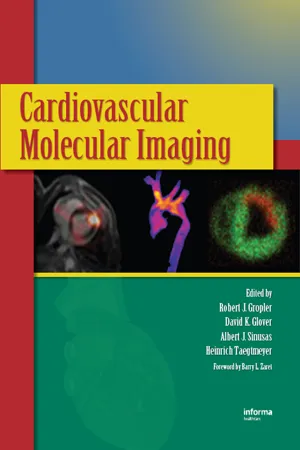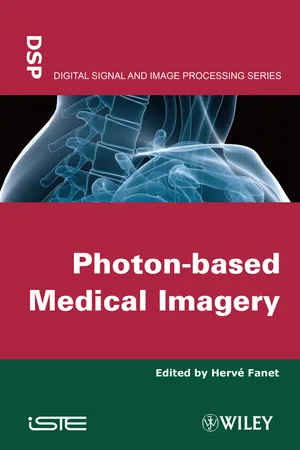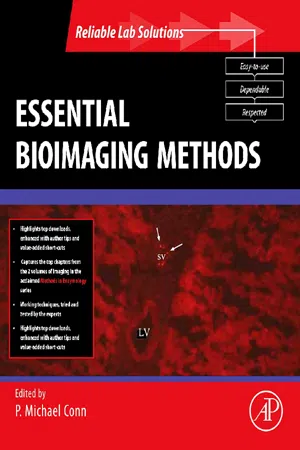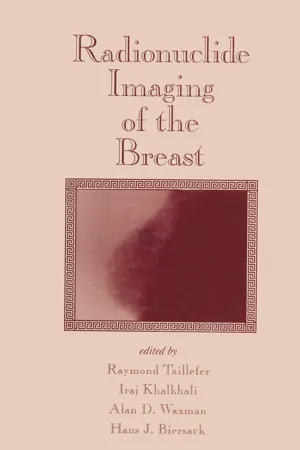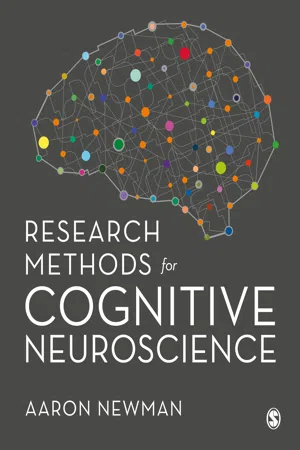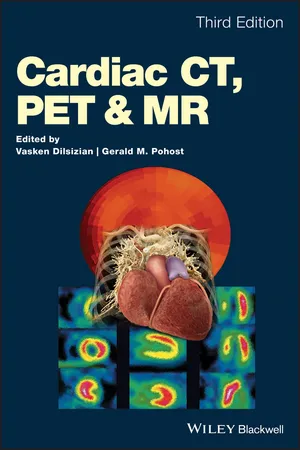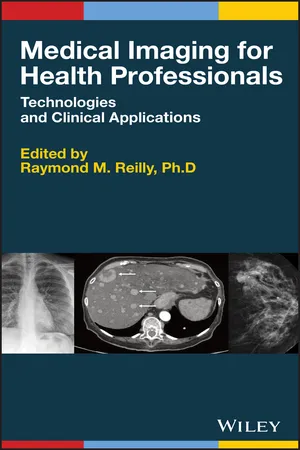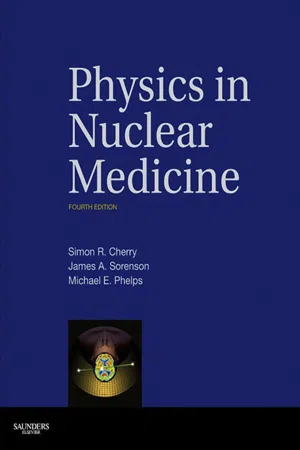Biological Sciences
PET Scan
A PET scan, or positron emission tomography scan, is a medical imaging technique that uses a radioactive substance to create 3D images of the body's functional processes. It is commonly used to detect diseases such as cancer, assess brain function, and evaluate heart conditions. PET scans can provide detailed information about the body's metabolism and help in diagnosing and monitoring various medical conditions.
Written by Perlego with AI-assistance
Related key terms
Related key terms
1 of 4
Related key terms
1 of 3
10 Key excerpts on "PET Scan"
- eBook - ePub
- Robert J. Gropler, David K. Glover, Albert J. Sinusas, Robert J. Gropler, David K. Glover, Albert J. Sinusas(Authors)
- 2007(Publication Date)
- CRC Press(Publisher)
2PET/microPET Imaging
Yuan-Chuan Tai
Mallinckrodt Institute of Radiology, Washington University School of Medicine, St. Louis, Missouri, U.S.A.INTRODUCTION
Positron emission tomography (PET) is a nuclear medicine imaging technique that provides three-dimensional (3D) tomographic images of radiotracer distribution within a living subject (1 ,2 ). Proton-rich radionuclides such as 11 C, 13 N, 15 O, 18 F, 64 Cu, 68 Ga, and 82 Rb can be used to label biological molecules of interest. Typically, trace quantities (pico-molar) of biomolecules are administered into subjects to be imaged. Radiotracer concentration can be measured quantitatively over a period of time. These quantitative measurements, combined with tracer kinetic modeling technique, permit different biological processes to be modeled without intervention (3 ,4 ,5 ,6 ). PET has been widely accepted for clinical diagnosis of various types of diseases (neurological, cardiac, and oncological). Equally important is PET’s role in basic sciences, in which carefully engineered and labeled bio-molecules are employed to study various biological processes in human subjects and laboratory animals (7 ). The development of bio-molecules and their applications in cardiovascular research will be discussed in more detail in other chapters of this book. The underlying physics and detector technologies of PET and high-resolution animal PET, as well as the techniques involved in quantitative PET imaging, will be introduced in this chapter.FUNDAMENTALS OF PET
Physics
The physical property to be measured by PET is the activity concentration of radiolabeled tracer in a subject. Figure 1 illustrates the source of signal and the theory of detection. Bio-molecules [e.g., 18 F-fluorodeoxyglucose (FDG) in Fig. 1 - eBook - ePub
- Hervé Fanet, Hervé Fanet(Authors)
- 2013(Publication Date)
- Wiley-ISTE(Publisher)
5.1. IntroductionSince its emergence in the 1950s to detect and to locate cerebral tumors after an injection of gallium-68 (68 Ga), positron-emission tomography (PET) established itself as the reference method for the staging of many types of cancers, such as lung cancer, lymphoma, colon cancer, melanoma, and early evaluation of cancer treatment. Its advantage is its ability to probe molecular processes in humans and animals in vivo, in an a traumatic way by the incorporation of a radioactive vector (which is most frequently used) that is incorporated into the molecular processes. There are a variety of processes accessible with PET, and more remarkably, the information provided by the PET is quantitative with a very finite rating scale, which is close to the femtomolar scale.In France today, over 50 PET systems are installed in nuclear medicine departments and cancer centers. Most of the time, these systems are dedicated to the clinical workup of glucose metabolism in oncology. Over 10 centers have a cyclotron, the majority are jointly operated by commercial distributors of radiopharmaceuticals with a license to distribute.With the impetus of biomedical applications, the systems have considerably evolved in two major directions: multi-modality imaging to improve the diagnosis with PET and systems with higher performance in spatial resolution and in detection efficiency for small animal imaging.5.1.1. Definition
PET measures the spatial and time distribution of a radiopharmaceutical specific to a molecular process in man and animals. This radiopharmaceutical is most often intravenously injected in the subject. Following the tracer injection, a three-dimensional (3D) map of the characteristic parameter(s) of the molecular process within the organs is obtained. - eBook - ePub
- P. Michael Conn(Author)
- 2009(Publication Date)
- Academic Press(Publisher)
Chapter 1. Positron Emission Tomography (PET) Research to Clinical PracticeRakesh Kumar* and Suman Jana†
* Department of Nuclear Medicine and PET, All India Institute of Medical Sciences, New Delhi 110029, India† Cardiovascular Research Center, University of Kentucky, Lexington, Kentucky 40536-0200I. IntroductionII. TracersIII. Drug EvaluationA. Small Animal PET Imaging (Micro-PET)IV. Biological Function EvaluationV. Clinical ApplicationsA. PET in OncologyB. PET in NeurologyC. PET in CardiologyD. PET in Infectious and Inflammatory DiseasesVI. Future PerspectivesA. Assessment of Multidrug ResistanceB. Quantitation of AngiogenesisC. Tumor HypoxiaD. ApoptosisE. Gene ExpressionVII. ConclusionsReferencesI. IntroductionPositron emission tomography (PET) is an advanced diagnostic imaging technique, which cannot only detect and localize but also quantify physiological and biochemical processes in the body noninvasively. The ability of PET to study various biological processes opens up new possibilities for both fundamental research and day-to-day clinical use. PET imaging utilizes β-emitting radionuclides such as 11 C, 13 N, 15 O, and 18 F, which can replace their respective stable nuclei in biologically active molecules. These radionuclides decay by positron emission. After being emitted from the nucleus, a positron will combine with a nearby electron through a process known as annihilation. Annihilation converts the mass of both particles into energy in the form of two antiparallel 511-keV γ-rays. The PET detectors are arranged in a ring in order to detect these γ-rays.At present, 2-deoxy-2-[18 F] fluoro-d -glucose (18 F-FDG) is the most commonly used positron-emitting radiopharmaceutical used for PET imaging. 18 F-FDG is a radioactive analog of glucose and is able to detect altered glucose metabolism in pathological processes. Like glucose, FDG is transported into cells by means of a glucose transporter protein and begins to follow the glycolytic pathway. FDG is subsequently phosphorylated by an enzyme known as hexokinase to form FDG-6-phosphate (McGowan et al., 1995 and Wahl, 1996 - eBook - ePub
Handbook of In Vivo Chemistry in Mice
From Lab to Living System
- Katsunori Tanaka, Kenward Vong(Authors)
- 2019(Publication Date)
- Wiley-VCH(Publisher)
5 Positron Emission Tomography (PET) Imaging in Live AnimalsXiaowei Ma and Zhen ChengStanford University, Department of Radiology, 1201 Welch Road, Lucas Center, P095, Stanford, CA, 94305‐5484, USA5.1 Introduction
Positron emission tomography (PET ) is a highly sensitive noninvasive functional imaging technology that is ideally suited for monitoring the molecular biological processes in the course of diseases in vivo. By detecting the gamma rays emitted from the radioisotope‐labeled tracer in the body, three‐dimensional images can be reconstructed to show the location and concentration of the tracer corresponding to the bioactivities. PET imaging can obtain different information of diseases such as diagnostic and/or prognostic information by using different kinds of radioisotope‐labeled tracers. It can be used to monitor perfusion, metabolic rate, gene expression, protein expression, receptor binding, and many other events. With noninvasive PET imaging, we can investigate disease progression or molecular change in real time in vivo. The power of PET makes it an attractive technology in standard medical care in recent years.The decisive influence of PET imaging in preclinical usage has motivated scientists to develop a miniaturized version of a PET Scanner called micro‐PET for noninvasive molecular imaging of laboratory animals. With the tremendous advances in biotechnology, a wide range of small laboratory animal models, such as mice and rats, have been used to study human disease progress. Therefore, it has significantly motivated the extent of PET technique for small‐animal imaging. With the galloping progress of technology, many micro‐PET Scanners have been designed and made with high performance. They have facilitated the development of molecular imaging assays in small‐animal models, which is a very important basis for clinical translation. The micro‐PET imaging studies could supply pharmacokinetic data of tracers and optimize the imaging signal acquirement. Micro‐PET Scanners have played a crucial role in biology, scientific research, and drug development for many kinds of diseases such as tumor, neurological diseases, and cardiovascular diseases. One of the most important and powerful feature of micro‐PET is the ability to validate tracers in animal models and then translate them from these preclinical models to clinical applications using the same tracers in clinical PET sites around the world. - eBook - ePub
- Raymond Taillefer, Iraj Khalkhali, Alan D. Waxman, Hans J. Biersack, Raymond Taillefer, Iraj Khalkhali, Alan D. Waxman, Hans J. Biersack(Authors)
- 2021(Publication Date)
- CRC Press(Publisher)
4 Breast Imaging with Positron Emission TomographyHANS BENDER , HOLGER PALMEDO , and HANS J. BIERSACK University of Bonn, Bonn, Germany AXEL SCHOMBURG Roentgeninstitut, Dusseldorf, GermanyI. INTRODUCTION
A. Historical Background
Positron emission tomography (PET) is a cross-sectional, nuclear medicine imaging technique that provides functional images of the body (e.g., by visualization of metabolic processes, expression of transporters, receptors, etc.). PET combines a series of characteristics/abilities that could not be realized in standard nuclear medicine applications:1. Quantitation: While gamma rays can not be focused like visible light, the collimator technology allows a sufficient but limited substitute. The major limitation is due to the fact that gamma rays can not be stopped but only attenuated. By this way, the assumed volume of an imaged lesion is related to the accumulated activity. Thus, the higher the accumulated activity within a defined volume, the latter it appears on the display unit.2. Resolution: The above-mentioned physical limitation of single-gamma ray imaging does not only limit true/accurate volume estimates but also limits the resolution of the system. In addition, deeply located and small lesions are significantly masked by attenuation and scatter, while the detected size seems to increase with the distance of the object from the collimator.3. Production of biologically identical tracers: Certain positron emitters (11 C, 15 O, 13 - eBook - ePub
- Graham Lappin, Simon Temple(Authors)
- 2006(Publication Date)
- CRC Press(Publisher)
hapter 11Barbara S. Koetz and Patricia M. Price CONTENTSPositron Emission Tomography
- 11.1 Introduction
- 11.2 General Principles of PET
- 11.3 Spatial Resolution and Detectors
- 11.4 Data Gathering and Interpretation
- 11.5 Isotope Generation Using a Cyclotron
- 11.6 Choice of Radioisotopes
- 11.7 Labeled Ligand and Drug Synthesis
- 11.8 PET Application: Pharmacokinetic Studies
- 11.8.1 Bioavailability and Kinetics
- 11.8.2 Receptor Ligand Imaging
- 11.9 Pharmacodynamic Studies
- 11.9.1 Imaging Glucose Metabolism with [18 F]-Fluoro-Deoxyglucose
- 11.9.2 Imaging Hemodynamic Parameters with 15 O-Labeled Water
- References
11.1 Introduction
Although the potential value of imaging with positron-emitting radionuclides was envisaged more than half a century ago, only more recent advances in radio-chemistry, scintillation detection, electronics, and computer capacities for image reconstruction allowed further development of this functional imaging modality to become a valuable tool in research and drug development. Positron emission tomography (PET) now has the potential for in vivo imaging of drug pharmacokinetics, pharmacodynamic endpoints, molecular pathways, and gene expression. Human studies with minute amounts of the labeled pharmacological compound, known as PET microdosing, can be performed, which can avoid some uncertainties that arise with respect to tissue pharmacokinetics from animal models and is hoped to reduce the need for studies on animals in the future.11.2 General Principles of PET
Multiple steps are involved in the PET process, which starts with the selection of a suitable biological tracer, which is then labeled with a positron-emitting radioisotope, administered to an organism, and imaged in vivo in a quantitative way to reveal its distribution. The biological tracer can theoretically be any molecule or chemical compound that can be marked with a radionuclide. PET employs radionuclides of biologically important elements, such as 11 C, 13 N, 15 O and 18 F, which decay by pure positron emission (Section 2.3.3 - eBook - ePub
- Aaron Newman(Author)
- 2019(Publication Date)
- SAGE Publications Ltd(Publisher)
Although PET has some significant limitations relative to fMRI – including much lower temporal resolution, moderately lower spatial resolution, and the need to use radioactivity – it has some advantages as well. These include the ability to image neuromodulator concentrations and disease markers, as well as the fact that there is no magnetic field or RF energy that, in MRI, precludes scanning people with some implanted devices such as cochlear implants. An exciting recent technical advance is scanners that combine PET and MRI in a single unit. These open up possibilities of simultaneous multimodal neuroimaging that could provide greater insight into functional brain activation, as well as enhanced understanding of the physiological processes underlying the fMRI BOLD response.Things You Should Know- The PET signal is created by radioactive decay of atoms that are unstable due to having one more proton than neutrons. Such atoms stabilize by converting one proton to a neutron, emitting a positron in the process. Positrons travel a short distance before encountering an electron and being annihilated, resulting in the formation of a pair of photons which travel in opposite directions at the speed of light.
- PET Scanners detect and localize these positrons through scintillation detectors tuned to the photons emitted by positron annihilation. PET Scanners consist of a number of detector rings; the number of these determines the number of slices the PET image can contain. Coincidence detectors are used to identify pairs of photons that arrive simultaneously at two detectors along a line of response passing through the tissue. Since the origin of the photon could be anywhere along that line of response, PET data must be reconstructed through back-projection. This involves computing, for each location in the image volume, the number of detections occurring along lines of response passing through that location. This can be done exclusively within each detector ring, for 2D imaging, or across rings for 3D imaging.
- The radioactive substances introduced into the body for PET imaging are called positron-emitting radioligands (PERs). These generally involve a chemically unstable atom bound to a molecule of physiological interest, such as oxygen or glucose. PERs have a short half-life and therefore must be synthesized in a cyclotron shortly before use. Common PERs for functional imaging include oxygen (15 O, for measuring cerebral blow flow or oxygen metabolism) and fluorodeoxyglucose (18 FDG, for measuring glucose metabolism). As well, a number of PERs are used to trace specific neuromodulator systems, including 18
- eBook - ePub
- Vasken Dilsizian, Gerald M. Pohost, Vasken Dilsizian, Gerald M. Pohost(Authors)
- 2019(Publication Date)
- Wiley-Blackwell(Publisher)
1 Positron Emission Tomography Juan José Vaquero1 and Stephen L. Bacharach21Universidad Carlos III de Madrid and Instituto de Investigación Sanitaria Gregorio Marañón, Madrid, Spain2University of California at San Francisco, San Francisco, CA, USAIntroduction
The goal of all cardiac nuclear imaging is to trace the fate of radioactively labeled biochemical compounds (tracers) within the body, usually in the myocardium or blood pool. One usually either makes a static image of the distribution of the radiotracer (e.g., technetium‐99m (99m Tc) sestamibi (methoxyisobutylisonitrile or MIBI) or thalium‐201 (201 Tl)) or follows the uptake and clearance of the tracer with time. In the former case, static imaging is all that is required, while in the latter a series of images, acquired dynamically over time, is necessary. Positron emission tomography (PET) has these same goals. Although PET works in a manner very similar to conventional tomographic nuclear imaging techniques (e.g., single photon emission computed tomography or SPECT), there are some very significant differences. It is these differences that make PET of great potential value in nuclear cardiology, and it is these differences we will emphasize in this chapter.Positron Decay
PET tracers, as their name implies, decay by emission of a positron. Except for their opposite charge, positrons are nearly identical to ordinary negatively charged electrons (which in fact are often called “negatrons”). They have the same mass and behave similarly when passing through the body. Positrons, however, are the “antimatter” of electrons. When a positron and an electron are in close proximity for more than the briefest interval, both will disappear (an event called “annihilation”), and their masses will be converted into energy in the form of two gamma rays traveling in almost exactly opposite directions. The energy of each photon is 0.511 MeV (precisely the equivalent energy corresponding to the mass of the electron or positron). These photons are sometimes called “annihilation” photons. The two photons travel in nearly exactly opposite directions in order to conserve momentum. The entire process is illustrated in Figure 1.1 . In this figure it is assumed that a positron emitter (in this case carbon‐11 (11 C)) is part of a tracer somewhere in the body (e.g., the myocardium). When the positron is emitted from the nucleus it is traveling at very high speed, nearly the speed of light. It moves through the tissue just as an electron would, bouncing off many of the atoms and losing energy as it does so. The final distance between the original atom and the annihilation point is called the “positron range.” Eventually (typically within a millimeter or so, depending on the radionuclide) it slows down enough to spend a significant time near an electron. As soon as this happens the two annihilate and the two gamma rays (each with 0.511 MeV) are emitted, as shown in Figure 1.1 - eBook - ePub
Medical Imaging for Health Professionals
Technologies and Clinical Applications
- Raymond M. Reilly, Raymond M. Reilly(Authors)
- 2019(Publication Date)
- Wiley(Publisher)
18 F‐FDG, a glucose analog, but there is an increasing use of other probes to assess perfusion, proliferation, hypoxia, or expression of receptors. In the coming decades, we will likely see an increase in the use of PET using novel probes to assess for the presence of specific features of a disease process, clinically and in research. These unique molecular imaging techniques may improve individualized therapy planning and may result in improved therapy outcome.References
- 1 Thakur, M. and Lentle, B.C. (2005). Report of a summit on molecular imaging. Radiology 236: 753–755.
- 2 Townsend, D.W., Carney, J.P., Yap, J.T., and Hall, N.C. (2004). PET/CT today and tomorrow. J. Nucl. Med. 45 (Suppl 1): 4S–14S.
- 3 Metser, U., Miller, E., Lerman, H., and Even‐Sapir, E. (2007). Benign nonphysiologic lesions with increased 18 F‐FDG uptake on PET/CT: characterization and incidence. AJR Am. J. Roentgenol. 189: 1203–1210.
- 4 Sainz‐Esteban, A., Prasad, V., Schuchardt, C. et al. (2012). Comparison of sequential planar 177 Lu‐DOTA‐TATE dosimetry scans with 68 Ga‐DOTA‐TATE PET/CT images in patients with metastasized neuroendocrine tumours undergoing peptide receptor radionuclide therapy. Eur. J. Nucl. Med. Mol. Imaging 39: 501–511.
- 5 Pauwels, E.K., Ribeiro, M.J., Stoot, J.H. et al. (1998). FDG accumulation and tumor biology. Nucl. Med. Biol. 25: 317–322.
- 6 Bar‐Shalom, R., Yefremov, N., Guralnik, L. et al. (2003). Clinical performance of PET/CT in evaluation of cancer: additional value for diagnostic imaging and patient management. J. Nucl. Med. 44: 1200–1209.
- 7 Martin, R.C., Fulham, M., Shannon, K.F. et al. (2009). Accuracy of positron emission tomography in the evaluation of patients treated with chemoradiotherapy for mucosal head and neck cancer. Head Neck 31: 244–250.
- 8 Gregory, D.L., Hicks, R.J., Hogg, A. et al. (2012). Effect of PET/CT on management of patients with non‐small cell lung cancer: results of a prospective study with 5‐year survival data. J. Nucl. Med. 53: 1007–1015.
- 9 Hillner, B.E., Siegel, B.A., Hanna, L. et al. (2012). Impact of 18 F‐FDG PET used after initial treatment of cancer: comparison of the National Oncologic PET Registry 2006 and 2009 cohorts. J. Nucl. Med.
- eBook - ePub
- Simon R. Cherry, James A. Sorenson, Michael E. Phelps(Authors)
- 2012(Publication Date)
- Saunders(Publisher)
The uptake of FDG reflects glucose metabolism in tissues. Many pathologic conditions can cause regionally specific alterations in glucose metabolism that can be detected using FDG-PET. PET's most widespread application has been for the detection and staging of cancer, for which whole-body FDG studies have become an important tool in staging patients and for deciding patient management. A whole-body FDG study is shown in Figure 18-27. FIGURE 18-27 Whole-body 18 F-fluorodeoxyglucose PET Scan (injected activity 370 MBq) of a patient with cancer, showing widespread metastatic disease (dark spots). The scan took 14 minutes to acquire (7 overlapping bed positions to cover thorax and abdomen, 2 minutes per bed position), with imaging commencing 60 minutes post-injection. (Courtesy Dr. Paul Shreve, Spectrum Health, Grand Rapids, MI and Siemens, Medical Solutions USA, Inc., Knoxville, TN.) FDG also is used diagnostically in conjunction with blood flow tracers such as 13 N-ammonia or 82 RbCl to evaluate myocardial viability and stratify patients with coronary artery disease with regard to bypass surgery. In the brain, PET is used diagnostically in a range of neurodegenerative diseases (Alzheimer's disease, Parkinson's disease) and dementia, for epilepsy, neurodevelopmental disorders and in psychiatric disorders. Metabolic FDG images of a patient with Alzheimer's disease compared with those of a normal control are shown in Figure 18-28. FIGURE 18-28 Transaxial image slices showing 18 F-fluorodeoxyglucose uptake at two different levels of the brain in a normal volunteer (control) and in a patient at an early stage of Alzheimer's disease. Data acquisition times were ~ 30 minutes and injected doses were 370 MBq (10 mCi). Arrows indicate metabolic deficits in the patient's images
Index pages curate the most relevant extracts from our library of academic textbooks. They’ve been created using an in-house natural language model (NLM), each adding context and meaning to key research topics.
Explore more topic indexes
Explore more topic indexes
1 of 6
Explore more topic indexes
1 of 4
